|
|
|
Sort Order |
|
|
|
Items / Page
|
|
|
|
|
|
|
| Srl | Item |
| 1 |
ID:
106232
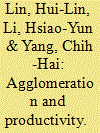

|
|
|
|
|
| Publication |
2011.
|
| Summary/Abstract |
Is the spatial concentration of manufacturing activity able to enhance firm-level productivity? This question is particularly relevant to production in China, which has a huge territory and population, but a skewed distribution in terms of urban-rural development. This paper aims to examine the dynamics of industrial agglomeration and the impact of agglomeration on firm-level productivity in China's textile industry by using a firm-level panel dataset from 2000 to 2005. First, the average value of the Ellison-Glaeser (EG) index (city level) is found to be approximately 0.00019. Moreover, the calculated city EG index of spatial concentration for each year exhibits a decreasing trend of spatial agglomeration for garments and other fiber products, but an increasing trend for the textile industries' agglomeration in China. The above findings are similar to the findings of Lu and Tao (2009). Secondly and importantly, this study finds an inverted U-shape relationship between agglomeration and productivity. It suggests that while industrial agglomeration enhances firms' productivity, agglomeration diseconomies may appear if the degree of agglomeration is too high.
|
|
|
|
|
|
|
|
|
|
|
|
|
|
|
|
| 2 |
ID:
141400
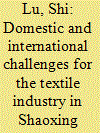

|
|
|
|
|
| Summary/Abstract |
This article recounts the transformations that have taken place in the textile industry in Shaoxing, Zhejiang Province, over the course of the past 30 years. It reveals the importance of the local setup and the links that have built up between companies, markets, and the state and its departments. It also exposes the difficulties experienced by companies as they try to adapt to their changing environment, whether in terms of opportunities offered by the domestic or international markets, or new regulations.
|
|
|
|
|
|
|
|
|
|
|
|
|
|
|
|
| 3 |
ID:
099313
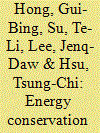

|
|
|
|
|
| Publication |
2010.
|
| Summary/Abstract |
Since Taiwan lacks sufficient self-produced energy, increasing energy efficiency and energy savings are essential aspects of Taiwan's energy policy. This work summarizes the energy savings implemented by 303 firms in Taiwan's textile industry from the on-line Energy Declaration System in 2008. It was found that the total implemented energy savings amounted to 46,074 ton of oil equivalent (TOE). The energy saving was equivalent to 94,614 MWh of electricity, 23,686 kl of fuel oil and 4887 ton of fuel coal. It represented a potential reduction of 143,669 ton in carbon dioxide emissions, equivalent to the annual carbon dioxide absorption capacity of a 3848 ha plantation forest. This study summarizes energy-saving measures for energy users and identifies the areas for making energy saving to provide an energy efficiency baseline.
|
|
|
|
|
|
|
|
|
|
|
|
|
|
|
|
| 4 |
ID:
044529
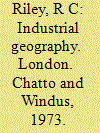

|
|
|
|
|
| Publication |
London, Chatto and Windus, 1973.
|
| Description |
xii, 228p.;mapsHbk
|
| Standard Number |
0701119551
|
|
|
|
|
|
|
|
|
|
|
|
Copies: C:1/I:0,R:0,Q:0
Circulation
| Accession# | Call# | Current Location | Status | Policy | Location |
| 012128 | 910.1338/RIL 012128 | Main | On Shelf | General | |
|
|
|
|
| 5 |
ID:
105228


|
|
|
|
|
| Publication |
2011.
|
| Summary/Abstract |
This article examines the capabilities of Cambodia's garment industry in the post-safeguard policy era, and its future prospects. It first analyzes the industry's experience pre-2005, then discusses the role of foreign investors and the government's open-economy policy. The paper then looks at post-2005 industry problems and offers some recommendations for future growth.
|
|
|
|
|
|
|
|
|
|
|
|
|
|
|
|
| 6 |
ID:
144042
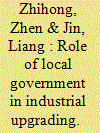

|
|
|
|
|
| Summary/Abstract |
This article examines China’s largest textile industrial cluster in Shaoxing county as a case study of how developing countries could carry out industrial upgrading in the face of globalisation’s challenges. The authors argue that the local government could play a crucial role in transforming comparative advantages of the local economy into competitive advantages using various policy tools. The Shaoxing county government rewarded and subsidised local textile enterprises to carry out independent innovation and research and development (R&D), facilitated foreign investments and technology transfer, guided local enterprises to build up their own brands, introduced preferential policies to encourage local enterprises to participate in international competition and motivated local enterprises to expand export. This demonstrates that the county government’s guiding hand and policy measures are instrumental in leading textile enterprises to reshape their competitive advantage, integrate into the global market and upgrade the industry.
|
|
|
|
|
|
|
|
|
|
|
|
|
|
|
|
| 7 |
ID:
141399


|
|
|
|
|
| Summary/Abstract |
Shanghai’s modern fashion industry developed between the last decades of the nineteenth century and the 1930s and was an important step in China’s industrialisation. The present article aims to define the relationship between production and consumption in Shanghai’s modern fashion industry. One of the main characteristics of modern fashion is its ability to innovate by creating new and distinct trends while absorbing different influences. Shanghai modern fashion was an original mix of Chinese and foreign styles. The second determinant of this phenomenon is its capacity to be distinctive and reproducible at the same time. Shanghai’s modern fashion therefore only emerged when the city was able to innovate and produce goods on a massive scale that were adapted to consumer tastes. To prove this relationship, the present article establishes concrete links between traders, industrialists, and retailers. The textile industry benefited from the outcome of a complex network that linked foreign trade, cotton mills, retail shops, and mass publicity. This paper analyses how this economic network was developed.
|
|
|
|
|
|
|
|
|
|
|
|
|
|
|
|
|
|
|
|
|